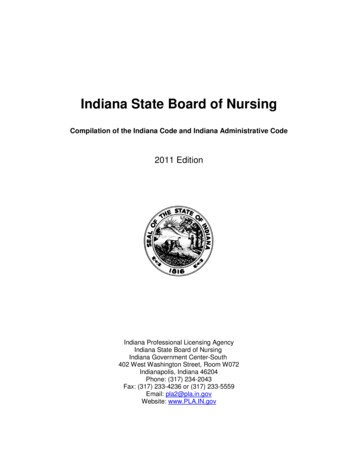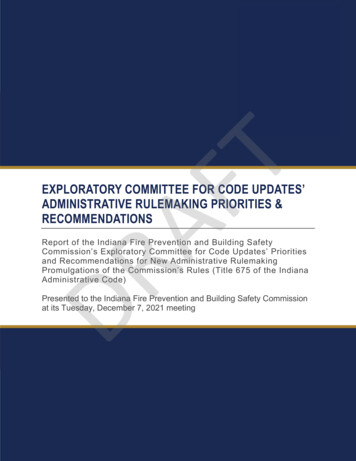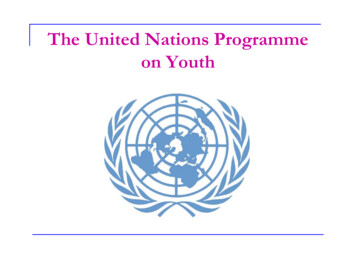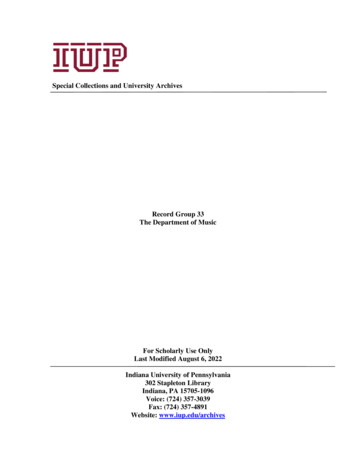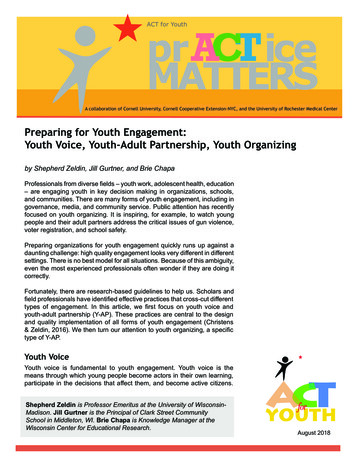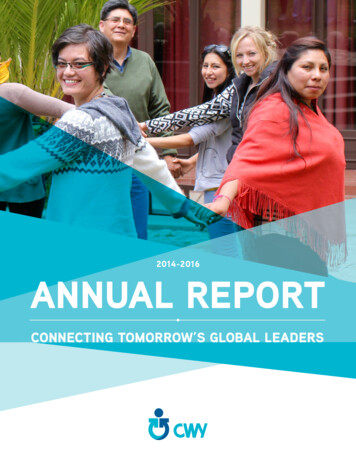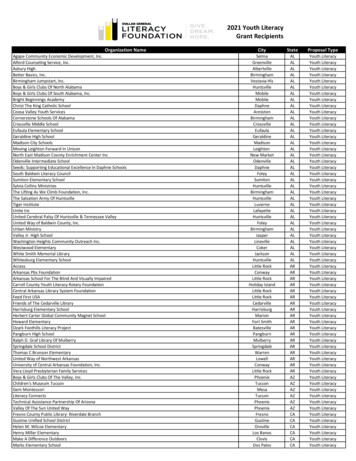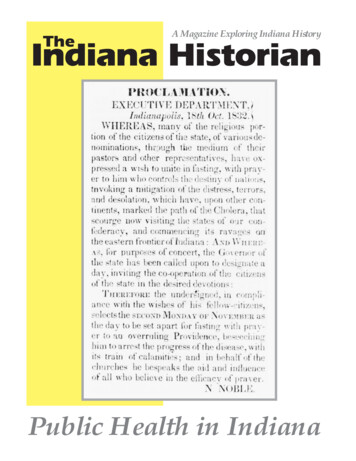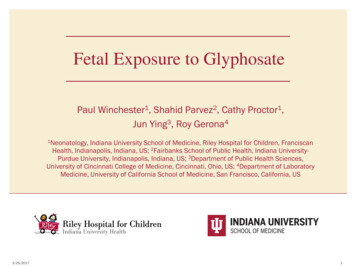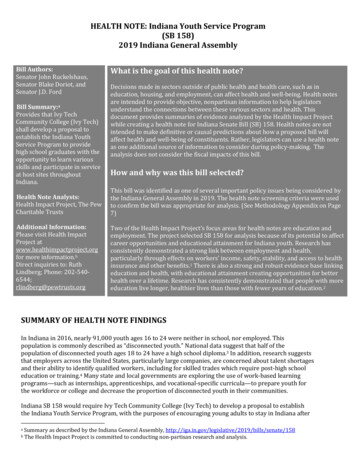
Transcription
HEALTH NOTE: Indiana Youth Service Program(SB 158)2019 Indiana General AssemblyBill Authors:Senator John Ruckelshaus,Senator Blake Doriot, andSenator J.D. FordBill Summary:aProvides that Ivy TechCommunity College (Ivy Tech)shall develop a proposal toestablish the Indiana YouthService Program to providehigh school graduates with theopportunity to learn variousskills and participate in serviceat host sites throughoutIndiana.What is the goal of this health note?Decisions made in sectors outside of public health and health care, such as ineducation, housing, and employment, can affect health and well-being. Health notesare intended to provide objective, nonpartisan information to help legislatorsunderstand the connections between these various sectors and health. Thisdocument provides summaries of evidence analyzed by the Health Impact Projectwhile creating a health note for Indiana Senate Bill (SB) 158. Health notes are notintended to make definitive or causal predictions about how a proposed bill willaffect health and well-being of constituents. Rather, legislators can use a health noteas one additional source of information to consider during policy-making. Theanalysis does not consider the fiscal impacts of this bill.How and why was this bill selected?Health Note Analysts:Health Impact Project, The PewCharitable TrustsThis bill was identified as one of several important policy issues being considered bythe Indiana General Assembly in 2019. The health note screening criteria were usedto confirm the bill was appropriate for analysis. (See Methodology Appendix on Page7)Additional Information:Please visit Health ImpactProject atwww.healthimpactproject.orgfor more information.bDirect inquiries to: RuthLindberg; Phone: 202-5406544;rlindberg@pewtrusts.orgTwo of the Health Impact Project’s focus areas for health notes are education andemployment. The project selected SB 158 for analysis because of its potential to affectcareer opportunities and educational attainment for Indiana youth. Research hasconsistently demonstrated a strong link between employment and health,particularly through effects on workers’ income, safety, stability, and access to healthinsurance and other benefits.1 There is also a strong and robust evidence base linkingeducation and health, with educational attainment creating opportunities for betterhealth over a lifetime. Research has consistently demonstrated that people with moreeducation live longer, healthier lives than those with fewer years of education.2SUMMARY OF HEALTH NOTE FINDINGSIn Indiana in 2016, nearly 91,000 youth ages 16 to 24 were neither in school, nor employed. Thispopulation is commonly described as “disconnected youth.” National data suggest that half of thepopulation of disconnected youth ages 18 to 24 have a high school diploma.3 In addition, research suggeststhat employers across the United States, particularly large companies, are concerned about talent shortagesand their ability to identify qualified workers, including for skilled trades which require post-high schooleducation or training.4 Many state and local governments are exploring the use of work-based learningprograms—such as internships, apprenticeships, and vocational-specific curricula—to prepare youth forthe workforce or college and decrease the proportion of disconnected youth in their communities.Indiana SB 158 would require Ivy Tech Community College (Ivy Tech) to develop a proposal to establishthe Indiana Youth Service Program, with the purposes of encouraging young adults to stay in Indiana afterabSummary as described by the Indiana General Assembly, 8The Health Impact Project is committed to conducting non-partisan research and analysis.
graduating from high school; providing youth with skills to help them enter the workforce or college; andpromoting a model of social engagement, relationship building, and civic participation among Indianayouth from diverse communities.5 Students graduating from high school in Indiana—including children infoster care, group homes, and other placements—would be eligible to participate in the program. Theprogram would connect participants with host sites, such as private employers in target sectors, nonprofitorganizations, or local government entities, to gain work experience. SB 158 would also direct Ivy Tech toexplore federal or grant funding for the program and opportunities to award participants with academiccredit, certification, or scholarships for their service.This health note prioritizes the components of SB 158 with the greatest potential to affect health. The noteexplores the evidence regarding youth workforce readiness and work-based learning programs and theireffects on participants’ employment and educational outcomes, and subsequent potential health effects. Itdoes not examine the extent to which workforce development and work-based learning programs aresuccessful in encouraging youth to remain in their home state, or any potential health effects stemmingfrom the economic effects associated with youth moving to other states.This review found that high-quality workforce readiness and work-based learning programs canlead to better jobs and increased earnings for participants, with positive implications for health.Jobs with higher wages help people afford resources important to health, such as safe housing and healthyfood.6 People with steady employment report better physical and mental health and lower stress andanxiety than do the recently unemployed, and those who are unemployed face higher rates of poor healthoutcomes than people who are employed.7 Employment can also facilitate access to benefits important tohealth, including access to paid leave, health insurance, and retirement funds.8 Below is a summary of keyfindings: There is a fair amount of evidencec that the quality of any youth workforce readiness or workbased learning program, and how well it is implemented, plays an important role in determiningwhether participants see beneficial effects on their employment or educational outcomes.9Therefore, the extent to which the Indiana Youth Service Program would affect educational,employment, and health outcomes for youth will ultimately depend on its components, structure,and implementation. There is a fair amount of evidence that high-quality workforce readiness and work-based learningprograms can lead to higher-quality jobs and increased earnings for participants.10 There is very strong evidence that having a steady job with adequate compensation can improvehealth and well-being. People with higher incomes live longer and experience better healthoutcomes than those living in poverty.11 To the extent that the Indiana Youth Service Program, ifimplemented, supports Indiana youth in securing stable, well-compensated jobs, those youth couldsee potential health benefits. There is a fair amount of evidence that there are essential components of workforce readinessprograms that may increase the likelihood of successful employment outcomes, includingfacilitating positive relationships with adults, providing opportunities for students to gainworkplace experience, and providing paid work-based learning opportunities.12 As described in SB158, the Indiana Youth Service Program would include several of these components. SB 158 directs Ivy Tech to explore opportunities to provide participants with certification as part oftheir service in the program. There is a fair amount of evidence that obtaining a certificate canboost students’ employment prospects and positively affect a person’s income.13 However, theevidence also shows substantial variation in earnings outcomes depending on the specific field ofstudy, whether the certificate holder works in their field of study, and the certificate holder’s sex,race, and ethnicity.14 Additionally, evidence suggests that people with vocational or technicalcSee definitions of strength of evidence ratings on Page 8.2
certificates may be particularly vulnerable to economic downturns compared with those withassociate’s or bachelor’s degrees.15 This research highlights the importance of training youth inhigh-demand fields and aligning workforce readiness programs with the local labor market.Research found mixed evidence on the effect of workforce development programs on educationalattainment, with some programs having no effect on college enrollment rates and othersdemonstrating increased rates.16 There is very strong evidence that higher educational attainmentis associated with better health outcomes, including decreased risk of mortality.17 Research hasconsistently demonstrated that Americans with more education live longer, healthier lives thanthose with fewer years of education.18 To the extent that the Indiana Youth Service Program, ifimplemented, encourages Indiana youth to obtain postsecondary degrees, those youth could seepotential health benefits.Methods Summary: To complete this health note, Health Impact Project staff conducted an expeditedliterature review using a systematic approach to minimize bias and identify studies to answer each of theidentified research questions. In this note, “health impacts” refer to effects on determinants of health, such aseducation, employment, and housing, as well as effects on health outcomes, such as injury, asthma, chronicdisease, and mental health. The strength of the evidence is qualitatively described and categorized as: notwell researched, mixed evidence, a fair amount of evidence, strong evidence, or very strong evidence. It wasbeyond the scope of analysis to consider the fiscal impacts of this bill or the effects any funds dedicated toimplementing the bill may have on other programs or initiatives in the state. To the extent that this billrequires funds to be shifted away from other purposes or would result in other initiatives not being funded,policymakers may want to consider additional research to understand the relative effect of devoting funds forthis bill relative to another purpose. A detailed description of the methods is provided in the MethodologyAppendix on Page 7.WHY DO THESE FINDINGS MATTER FOR INDIANA?Youth who are unemployed and not in school are commonly referred to as disconnected or opportunityyouth.19 In Indiana in 2016, the population of disconnected youth was 90,800 individuals, which is 10.7percent of the youth ages 16 to 24.20 The percentage of disconnected individuals is higher among black andLatino youth—18.8 percent and 13.6 percent, respectively—compared with 9.4 percent of white youth.21 Inaddition, the unemployment rate of youth ages 16 to 24 is higher than the rate for older age groups inIndiana.22 As of December 2018, the total unemployment rate in Indiana was 3.5 percent.23 According to2018 state unemployment estimates, the unemployment rate for individuals between 16 and 19 years ofage was 11.4 percent, and the rate was 7 percent for individuals ages 20 to 24.24 Upon high schoolgraduation, youth in Indiana enter one of several pathways including attending a four-year college, twoyear college, or technical training program; joining the military or workforce; and unemployment.25 In2017, among Indiana youth ages 18 to 24, 16.1 percent had less than a high school degree, 31.4 percent hada high school diploma or the equivalent, 43 percent had some college education or an associate’s degree,and 9.5 percent had a bachelor’s or more advanced degree.26 Indiana youth between 16 and 24 years of agemost often worked in the following industries: restaurants and other food services; colleges, universities,and professional schools, including junior colleges; construction; amusement, gambling, and recreationindustries; and department stores and discount stores.273
HOW DO WORKFORCE READINESS AND WORK-BASED LEARNING PROGRAMSAFFECT PARTICIPANTS?Effects of Youth Workforce Readiness and Work-Based Learning Programs on Health There is limited evidence exploring the effects of youth participating in workforcedevelopment and work-based learning programs on health. Research has examined theconnections between youth summer employment programs and health. Although such programsdiffer from the proposed Indiana Youth Service Program, the evidence suggests the potential foryouth workforce development and work-based learning programs to affect health. One study inNew York City, examining the Summer Youth Employment Program (SYEP), the largest summeremployment program for youth in the U.S., compared outcomes for 164,641 randomly-selectedparticipants ages 14 to 21 with outcomes for 129,459 youth who applied but were not selected.28Youth could participate in the lottery each year as long as they applied. SYEP participation at anytime between 2005 and 2008 decreased the probability of overall mortality by 17.97 percent by2014. Because this percentage reflects a reduction of 83 deaths, the study did not find statisticallysignificant differences by demographics groups; however, the data suggest this reduction is drivenby a lower number of deaths among male, Latino, and black youth who participated in the SYEP.Participation also decreased the probability of incarceration.Research consistently shows that as one’s education level increases, including throughcompletion of a vocational certificate, risk of death decreases.29 One study, using data from thePanel Study of Income Dynamics and National Death Index, found that among high schoolgraduates, completion of a vocational certification was independently associated with a reducedrisk of death.30 Although people with technical and vocational degrees have a higher risk ofmortality compared with those who have attained bachelor’s, master’s, or professional degrees,they have a lower risk of death compared with those whose highest level of education is somecollege or less.31 Research for this analysis did not identify any studies that examined whetherprograms that help move youth from a path of low educational attainment to higher educationalattainment change their health outcomes relative to a control group.Effects of Workforce Readiness and Work-Based Learning Programs on SubsequentEmployment, Earnings, and Educational Outcomes The Metropolitan Policy Program at Brookings and Child Trends identified three factors inyouth employment, education, and training experiences that are associated with youth fromdisadvantaged backgrounds having higher-quality jobs at the age of 29: work-based learningopportunities that foster positive relationships with adults; gaining experience in the labormarket between the ages of 16 and 18; and completing a two-year, four-year, or graduatepostsecondary degree, which was the strongest predictor of a high-quality job.32 The 2018report used longitudinal data from the National Longitudinal Survey of Youth 1997, defininghigher-quality jobs based on measures of earnings, benefits, hours of work, and job satisfaction.Evidence suggests that obtaining a certificate can positively affect a person’s income:Certificate holders earn 20 percent more compared with high school graduates who do nothave any postsecondary education.33 An increasing number of adults hold certificates fromvocational, technical, trade, or business programs. Data from the Survey of Income and ProgramParticipation show that the proportion of adults age 18 and older who have a certificate as theirhighest level of educational attainment grew from less than 2 percent in 1984 to nearly 12 percentin 2009.34 However, the evidence also shows substantial variation in earnings outcomes depending4
on the specific field of study, whether the certificate holder works in their field of study, and thecertificate holder’s sex, race, and ethnicity.Research shows that completing education beyond a high school degree can positively affectone’s earnings. Between 1965 and 2013 the median annual earnings for individuals ages 25 to 32with only a high school degree decreased by more than 3,000, while annual earnings forindividuals with a bachelor’s degree or higher rose by almost 7,000.35 Additionally, researchindicates that Indiana workers with a certificate see their earnings increase between the first andfifth years after program completion.36 However, salaries are higher for individuals with anassociate’s, bachelor’s, or graduate degree. Research has also explored the relationship betweenyouth summer employment programs and earnings. A study examining the Summer YouthEmployment Program in New York City (discussed above) found that although participation in theprogram increased earnings and employment for youth in the year they participated in theprogram, it caused a modest ( 100) decrease in average earnings for the three years followingparticipation.37Data suggest that students with vocational or technical certificates may be particularlyvulnerable to economic downturns compared with those with associate’s or bachelor’sdegrees.38 Research using panel data from the Youth Development Study examined effects of theGreat Recession of 2007-2009 on employment outcomes, and found that people ages 31 to 37 witha bachelor's or associate's degree were able to maintain high levels of employment, were morelikely to view their jobs as a career, and maintained higher levels of weekly hours at their jobsduring the recession compared with those without postsecondary degrees.39Research for this analysis found mixed evidence on the effect of workforce developmentprograms on educational attainment, with some programs having no effect on collegeenrollment rates and others demonstrating increased rates.40 Postsecondary degrees arebecoming increasingly critical to obtaining employment. Researchers estimate that, by 2020, 65percent of all jobs will require postsecondary education and training.41 Indeed, data show thedifferential employment rates based on educational attainment: In 2017, 70 percent of people age29 with a high school diploma or less were employed, compared with 88 percent of their peers withbachelor’s degrees.42 Research on the Summer Youth Employment Program in New York City(discussed above) found that the program had no impact on subsequent college enrollment.43Research suggests that workforce readiness and work-based learning programs maysupport youth in developing important “soft skills,” such as communication, problemsolving, and social skills. A growing body of research has demonstrated the importance of softskills to positive employment outcomes including obtaining a job, securing higher earnings andopportunities for advancement, and job stability.44 One qualitative study of individuals who hadparticipated in a work-based learning experience while in high school highlighted the perceivedvalue of the program to their maturity, time management skills, and self-awareness.45Correlates of Successful Workforce Readiness and Work-Based Learning Programs Research suggests that availability and access to programs that support workforce readinessamong youth will not guarantee benefits for employment and educational outcomes: Thequality and implementation of the programs play an important role.46 In addition, factors suchas local labor market demand and the match between high-quality jobs and the skills of availableworkers can affect the ability of youth to secure quality employment after completing certificate ortraining programs.47Research has identified essential components of workforce readiness programs that mayincrease the likelihood of successful employment outcomes, including facilitating positive5
relationships with adults, providing opportunities for students to gain workplaceexperience, and providing paid work-based learning opportunities.48o Researchers at Brookings conducted semi-structured interviews with the leaders of wellregarded science, technology, engineering and math (STEM)-focused workforce trainingprograms at community colleges across the United States to identify common themes ofworkforce training programs that seem to contribute to their success. The identified factorsincluded: engaging industry and employers in curriculum development for workforcetraining programs; providing opportunities for students to gain workplace experienceduring the program; taking an intensive approach to developing students’ math andtechnical skills; developing the program at a college with strong leadership and a culture ofinnovation; and access to funding from nonpublic sources, such as foundation funding.49o A 2016 report from the National Skills Coalition and National Youth Employment Coalitionidentifies elements of youth work-based learning programs that make the programssuccessful. These elements include: providing paid work-based learning opportunities;strong partnerships with businesses and community stakeholders; positive youthdevelopment and continued support; and linkages to connect youth to future education andtraining opportunities.50o A 2018 report by the Aspen Institute Workforce Strategies Initiative highlights theimportance of ensuring income for young adults during their participation in programs thattrain them for future jobs.51o Research suggests that programs that facilitate positive relationships with adults—throughmentoring, internship, apprenticeship, cooperative education, and career academies, forexample—have positive effects on youth employment and educational outcomes, includingemployment rates, job quality, earnings, and college enrollment.52WHICH POPULATIONS ARE MOST LIKELY TO BE AFFECTED BY THIS BILL?SB 158 encourages the Indiana Youth Service Program to select cohorts of participants from diversesocioeconomic, geographic, racial, ethnic, religious, and political backgrounds, and explicitly mentionsyouth in foster care and other placements stemming from interactions with the Indiana Department ofChild Services, courts, and other agencies. Research shows that the percentage of disconnected youth ishigher in Indiana among black and Latino youth compared to white youth.53 Disconnected youth are morelikely to come from disadvantaged backgrounds and often lack the social networks and support that canhelp them access health-promoting factors such as employment. Research also suggests that adolescentsfrom disadvantaged backgrounds—such as growing up in poverty—have lower rates of employment inadulthood and are less likely to have higher-quality jobs compared with their peers who did not face thesecircumstances.54 Low-income high school graduates face unique economic and social barriers that canhinder academic or work aspirations, including concerns about the cost of postsecondary education orcomplicating life events such as family illness.55 Compared with peers who are working or in school,disconnected youth are more likely to experience or report poor health, poverty, mental health disorders,incarceration, and criminal interactions later in life.56 If implemented, the Indiana Youth Service Programmay have the potential to positively affect youth who are already at disproportionate risk of negativeemployment, educational, and health outcomes.HOW LARGE MIGHT THE IMPACT BE?Where possible, the Health Impact Project describes how large the impact may be based on the billlanguage and literature, such as describing the size, extent, and population distribution of an effect. Thenumber of youth potentially affected by the Indiana Youth Service Program will depend on the size of the6
program. The fiscal note for the introduced version of SB 158 assumed a maximum of 50 participants ayear.57It was beyond the scope of this analysis to consider the fiscal impacts of this bill or the effects any fundsdedicated to implementing the bill may have on other programs or initiatives in the state. To the extent thatthis bill requires funds to be shifted away from other purposes or would result in other initiatives not beingfunded, policymakers may want to consider additional research to understand the relative effect ofdevoting funds for this bill relative to another purpose.APPENDIX: METHODOLOGYOnce the bill was selected, a research team from the Health Impact Project hypothesized a pathwaybetween the bill, heath determinants, and health outcomes. The hypothesized pathway was developedusing research team expertise and a preliminary review of the literature. The bill component was mappedto steps on this pathway and the team developed research questions and a list of keywords to search. Theresearch team reached consensus on the final conceptual model, research questions, contextualbackground questions, keywords, and keyword combinations. The conceptual model, research questions,search terms, and list of literature sources were peer-reviewed by an external subject matter expert. Theexternal subject matter expert also reviewed a draft of the note. A copy of the conceptual model is availableupon request.The Health Impact Project developed and prioritized 6 research questions related to the bill componentsexamined: To what extent do youth workforce development and college preparedness programs affect thefollowing: short-term and long-term employment outcomes for participants, job stability, income,and access to health care/insurance status? To what extent do youth service programs affect enrollment in and completion of higher educationdegree-seeking programs? To what extent do youth workforce development programs affect the rate at which young peoplemove out-of-state? To what extent do scholarships or compensation affect youth participation in workforcedevelopment and college preparedness programs? To what extent does participation in youth workforce and college preparedness programs affectthe following: behavioral health, physical health, and social engagement/social networks? What are barriers to and facilitators of participating in and completing workforce developmentand college preparedness programs?Next the research team conducted an expedited literature review using a systematic approach to minimizebias and answer each of the identified research questions.d The team limited the search to systematicreviews and meta-analyses of studies first, since they provide analyses of multiple studies or addressmultiple research questions. If no appropriate systematic reviews or meta-analyses were found for aspecific question, the team searched for nonsystematic research reviews, original articles, and researchreports from U.S. agencies and nonpartisan organizations. The team limited the search to electronicallyavailable sources published between January 2014 and January 2019.Expedited reviews streamline traditional literature review methods to synthesize evidence within a shortenedtimeframe. Prior research has demonstrated that conclusions of a rapid review versus a full systematic review did notvary greatly. Cameron A. et al., “Rapid versus full systematic reviews: an inventory of current methods and practice inHealth Technology Assessment,” (Australia: ASERNIP–S, 2007): dvsfull2007 systematicreview.pdf.d7
The research team searched PubMed and EBSCO databases along with the following leading journals inpublic health, higher education, workforce, and economics to explore each research question: AmericanJournal of Public Health, Social Science & Medicine, Health Affairs, Empirical Research in VocationalEducation and Training, The Quarterly Journal of Economics, and Higher Education, Skills and Work-basedLearning.e For all searches, the team used the following keywords: youth workforce development program,college preparedness program, youth apprenticeship, youth work-based learning, vocational education,employment outcomes, job stability, job insecurity, income, graduation rates, behavioral health, physicalhealth, social engagement, social networks, education outcomes, and barriers to completion. The team alsosearched Brookings Institution, National Skills Coalition, MDRC, and the Indiana Youth Institute foradditional research and resources outside of the peer-reviewed literature.After following the above protocol, the team screened 45 titles and abstracts,f identified 4 abstracts forpotential inclusion and reviewed the full text corresponding to each of these abstracts. After applying theinclusion criteria, 1 article was excluded. In addition, the team identified 4 additional peer-reviewedarticles through the original articles and identified 12 resources with relevant research outside of the peerreviewed literature. A final sample of 19 resources was used to create the health note. In addition, the teamused 11 references to provide contextual information.Of the studies included, the strength of the evidence was qualitatively described and categorized as: notwell researched, mixed evidence, a fair amount of evidence, strong evidence, or very strong evidence. Theevidence categories were adapted from a similar approach from another state.58Very strong evidence: the literature review yielded robust evidence supporting a causal relationship withfew if any contradictory findings. The evidence indicates that the scientific community largely accepts theexistence of the relationship.Strong evidence: the literature review yielded a large body of evidence on the association, but the body ofevidence contained some contradictory findings or studies that did not incorporate the most robust studydesigns or execution or had a higher than average risk of bias; or some combination of those factors.A fair amount of evidence: the literature review yielded several studies supporting the association, but alarge body of evidence was not established; or the review yielded a large body of evidence but findingswere inconsistent with only a slightly larger percent of the studies supporting the association; or theresearch did not incorporate the most robust study designs or execution or had a higher than average riskof bias.Mixed evidence: the literature review yielded several
Indiana SB 158 would require Ivy Tech Community College (Ivy Tech) to develop a proposal to establish . Program, with the purposes of encouraging young adults to stay in Indiana after a Summary as described by the Indiana General Assembly, . literature review using a systematic approach to minimize bias and identify studies to answer each .
